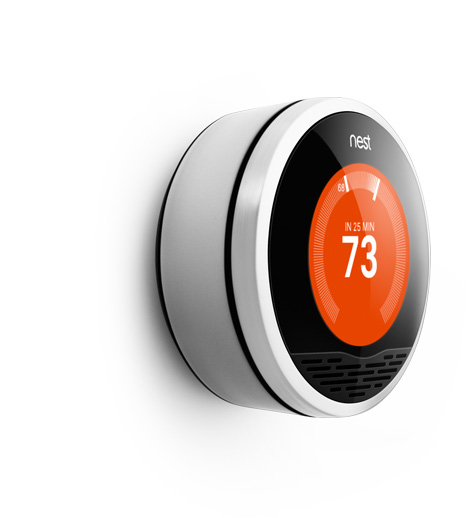Last week, Nest Labs launched a new programmable thermostat. It got a lot of press, not just because it’s expensive and innovative and beautiful, but because Nest Labs was founded by Tony Faddell, who led the iPod team for years, and senior leadership includes other key iPod team members and a MacArthur fellow.
I’ve spent a fair amount of time over the last year and a half thinking about programmable thermostats, and how to help homeowners save money by managing their energy use. Some of those thoughts I’m going to have to keep to myself, even though I’m no longer at EnergyHub, but there are a few things not directly related to my work there that I haven’t seen discussed in all of the hullaballoo, and I think one in particular is worth spending some time on.
Which is to say, I was really struck by the physical form of the thermostat itself. The company’s video tour highlights one of the cleverest touches - the stainless-steel outer case that allows it to blend more cleaning into the surrounding wall. After all, the whole reason most thermostats are beige is that it’s the lowest common denominator—Nest is solving the same problem more elegantly (though I do wonder about finger smudges…). But I really liked most of all that it’s a circle.
I grew up with a boxy beige thermostat with little lever-ish setpoint markers on the top. So to me personally, there’s nothing particularly resonant about the circular form factor. But after spending a lot of time talking to people about home HVAC systems, I know that l’m in the minority on that. The circular thermostat from Honeywell, designed by the great Henry Dreyfuss, is a minor icon of mid-century modernism: it’s just what a lot of people think of when you ask them to visualize a thermostat. The digital thermostat moved away from that shape to mark itself as something new (and also, to be frank, because it needed more space for its components). In time, the rectangular form factor became a marker of technological advance: you had something digital, programmable, and new.
The Nest Learning Thermostat takes another technological leap forward: it’s billed as a thermostat that learns its program from your behavior. It’s a thermostat with actual intelligence - possibly a scary thought on a cold night! How do they make it seem friendly and familiar regardless? Return to the circle. After the age of the impossible-to-program digital thermostat, the circle not only says “thermostat,” it says “simple and familiar.” From the manufacturer’s side, having the primary control be the stainless steel ring around the outside cut out the cost of a custom touchscreen component, and gave the design team the opportunity to design controls that (at least in the video) feel almost analog and yet highly precise at the same time.
The original iPod’s physical design, on launch, was constantly compared to a deck of cards. It needed to be small, to travel well, and it needed to be iconic, to stand out among the crappy existing options. The white earbuds were a brilliant touch, letting you display to everyone else at the gym or on the train how ahead of the curve you were. At home, though, it’s at least as much about comfort as display. A familiar form, an organic shape, something that’s beautiful up close but blends in at a distance, that’s what makes the Nest thermostat look premium in the home, and it’s almost the exact opposite of what made the iPod look premium in 2001. I still have a lot of questions about the Nest Learning Thermostat, but I’m beyond impressed by how much the people who made it know about making highly desirable consumer objects, and how much they were willing to learn from a classic.
